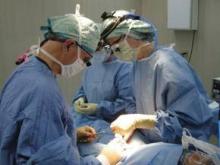After graduating from the Medical College of Georgia in Augusta, Dr. Julia Shelton wanted to go to a developing country, not only to see how other health systems are run but also to see if she could immerse herself in a system with limited resources, and still provide quality health care. That desire to test her mettle led her to participate in Vanderbilt University’s global surgical residency program at the AIC Kijabe Hospital in Kijabe, Kenya, a small town overlooking the Rift Valley, approximately an hour from Nairobi.
Recently back from that 4-week rotation, here Dr. Shelton recalls the highlights.
What was the facility like?
The hospital is quite large (at least 250 beds) and serves men, women, and children from the local area as well as from quite far away. I was as likely to treat someone from Kijabe as I was to treat someone from a variety of other East African countries. Although there are frequent trips based from Kijabe Hospital to other, less-resourced areas, for logistical and safety reasons I did not participate in these trips.
What type of equipment was available?
I was pleased to find that the equipment and resources at the hospital were substantial, although certainly different from what one is used to in a well-resourced hospital back home. This is actually one of the things I appreciated most – the comparatively limited resources can reveal how to do more with less, even when returning to one’s home institution.
What equipment did you miss most?
I really didn’t miss anything – you find yourself adapting to what is available. But being able to call a radiologist 24 hours a day to assist in the interpretation of imaging studies was something I found myself wishing I could do as I reviewed plain radiographs of trauma patients.
How many patients did you treat per day?
Depending on the patients’ surgical complexity, we would have 1-10 operative cases scheduled each day. Clinic averaged 40-50 patients per day. Our inpatient census varied between 5 and 15 patients.
Were there other Vanderbilt residents with you?
There were no other Vanderbilt residents there with me. There were, however, other residents from different institutions in the United States, Canada, Australia, etc. I was directly supervised by a Vanderbilt faculty member, and I worked closely with all members of the general surgical team (surgeons, residents, physician assistants, and nurses).
What types of cases were you seeing?
I saw patients with diseases ranging from benign skin lesions to perforated duodenal ulcers. One memorable case involved a young man with portal hypertension and splenomegaly resulting from schistosomiasis. Two years before I met him, he had undergone a procedure to ameliorate his portal hypertension by redirecting blood flow around his liver. Unfortunately, his splenomegaly continued to worsen. We arranged to take him to the OR to remove his spleen. Despite a long and arduous surgery, the patient recovered well and was discharged from the hospital after a brief recuperation.
What did you find to be some of the most challenging aspects of practicing medicine in this setting?
Limited resources sometimes simplified my day-to-day routine. For instance, there are limited medications available to treat postoperative pain, and although one could see this as a hindrance, I saw it as a challenge to effectively treat our patients given the available resources. Language was definitely a challenge although perhaps less so in Kenya, where a significant portion of the population speaks English. There were many times, however, when multiple translators were involved to translate from one African language to another, and then into English.
What were some of the expected and unexpected rewards from this experience?
What I appreciated most was the quality and accessibility of the education that I am receiving at my home institution. The medical trainees with whom I spent time have some of the few coveted surgical training positions available in Kenya. The number of people and the number of training programs are currently insufficient to meet the surgical needs of sub-Saharan Africa.
What ideas and experiences have you brought back from this global residency that you will use in your medical practice in the United States?
The main thing that stuck with me is that you really can do more with less.
For more information about the international surgery rotation at Vanderbilt University, Nashville, Tenn., visit the university’s website.
Think globally. Practice locally. U.S.-trained internists who have practiced abroad will receive a $100 stipend for contributing to this column. For details, visit the World Wide Med column at http://www.internalmedicinenews.com or send an e-mail to imnews@elsevier.com.

